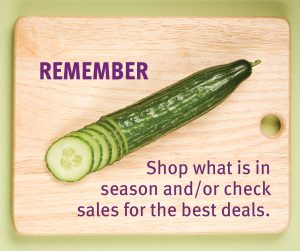How to Shop for Healthy Foods

“It costs too much to eat healthy” is a statement we hear a lot (or say to ourselves). The cost of feeding a family of four a healthy diet can run from $146 to $289 per week, according to the latest numbers from the U.S. Department of Agriculture. Those figures are based on preparing all meals and snacks at home for a couple with two school-aged children. They don’t include $1 deals at fast-food restaurants or splurges at pricey restaurants. 
It is possible to eat healthfully for closer to $146 a week, but planning ahead is key. You have to shop sales, buy produce in season, and buy canned and frozen vegetables when they are on sale. To eat inexpensively at home, you have to invest time into planning meals, grocery shopping, cooking, and preparing food.
Here are some simple tips for saving money at the grocery store:
- Don’t buy drinks: If your family is trying to eat healthy, hopefully you’ve already cut out things like soda and processed juices from your food budget. If not, do it now! If your family has consumed a lot of these beverages in the past, go back and look at the percentage of your food bill that they take up. In general, buying beverages in any prepared form is an expensive and unhealthy option.
- Keep an organized fridge and pantry: Leftovers are great, but burying them in the back of the fridge defeats the purpose of trying to budget. If you freeze extra food, make sure you periodically go through your freezer and use it.
- Repurpose leftovers: Consider cooking items that you can turn into sandwiches later (e.g., roast beef, meatloaf, meatballs, etc.), or protein (chicken, beans, or fish) that can be used to top a salad for the next day’s lunch.
- Buy fresh produce when it’s in season and freeze it: Remember, frozen produce is always a healthy option, too. Just make sure there is no added salt or sugar. You may also save money and reduce waste buying frozen since you don’t have to use it as quickly. If you find that a lot of fresh produce goes bad before you and your family can eat it, consider buying more frozen produce.
- Look for sales and plan meals accordingly: If the store you usually shop at has a weekly circular, check it every week and plan your meals around what’s on sale. This habit may force you to get creative and try some items or dishes you’ve never had.
BONUS TIP! If you you registered for the CDPHP Health Hub, powered by Virgin Pulse, then you have access to a personalized nutrition guide, including healthy recipes and more from Foodsmart.
- Embrace whole grains: Whole grains can really bulk up a meal and make it more filling (you might even end up eating less!), and they can be relatively inexpensive. Buy a package of whole-wheat couscous, brown rice, or quinoa. Cook then freeze in single portions to mix into salads or soups when you need them.
- Plan and prep meals ahead: I spend some time every weekend planning my meals for the week. Since I don’t mind leftovers, I often eat the same thing several times. I try to at least prep my lunches on Sunday so I’m starting the week off right.
Now, let’s talk about how to shop for healthy foods once you’re at the grocery store. You might have heard “shop the perimeter first,” and that’s good advice. The most nutritious foods are often found there.
- Fruit: Remember, fresh or frozen fruit is equally nutritious. Whole fruit is more filling and contains fewer calories per ounce (and more fiber) than juice. Dried fruits like prunes and apricots are nutrient-dense, but also calorie-dense, so watch the portion size and avoid added oils and/or sugar.

- Vegetables: Most vegetables have fewer calories per ounce than fruit due to their lower sugar content and are equally nutritious fresh or frozen (if packaged without salt). Remember, shop what is in season and/or check sales for the best deals.
- Poultry: Buy skinless cuts or remove the skin before cooking. Keep in mind that white meat is healthier while dark meat can have as much fat as red meat.
- Beef: Certain cuts can be healthier than others, like round, top round, and sirloin. Choose extra-lean ground beef (the label should say at least 90 percent lean). For all types of meat and poultry, avoid those that have been injected with salt-containing solutions, which add sodium.
- Fish: Look for fish varieties that are rich in omega-3 fatty acids, such as salmon, trout, and herring.
- Deli: Processed meats such as ham, sausage, frankfurters, and lunch or deli meats have added sodium, so check the ingredient and nutrition labels to limit sodium intake. Choose lean turkey, roast beef, ham, or low-fat/sodium lunchmeats.
- Dairy: Milk is a great source of calcium, vitamin D, and protein. Remember that cream cheese, cream, and butter have little to no calcium and do not count toward your three daily servings! Yogurt can be a healthy dairy choice; look for low-fat and non-fat options. Many yogurts are high in sugar, especially the flavored kind. Consider adding your own fruit to plain yogurt for a healthier option. Cheese provides calcium and protein but also adds fat, saturated fat, and sodium to your diet, so be sure to look for reduced-fat and reduced-sodium cheeses.
- Bread: Watch your portion/slice size. One ounce equals 28 grams of carbohydrates. Some breads have 43 grams per slice, which is about 1½ servings! According to the 2015 Dietary Guidelines for Americans, at least half our grains should come from whole grains. When choosing whole-grain products, make sure “whole” is the first word in the ingredients listing.
- Canned goods: Canned beans are generally a healthy protein source. Choose sodium-free or very low sodium products. Otherwise, opt for frozen produce.
- Snacks and cereals: Cereals can be a healthy part of your diet, so look for whole grains, high fiber, and no added sugar on the nutrition label. Snacks can be trickier to shop for. Avoid hydrogenated oil and look for low sodium and low fat. Better yet, skip these processed snacks and return to the produce section for fresh fruit and vegetables!
Now that you’re armed with the knowledge necessary to hit the grocery store, download our handy shopping list to help you plan for your trip. And, check out these previous posts if you’re looking for ideas about how to adopt an organic diet, pack healthy school lunches for your kids, or give healthy food-related gifts for the upcoming holiday season!
 The Daily Dose
The Daily Dose
 Meghan Marsolais
Meghan Marsolais
Comments are closed.